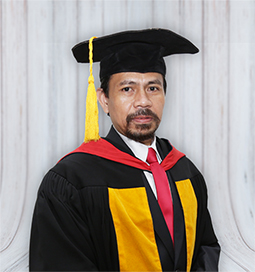Our Researcher

Prof. Dr. Deni Darmawan, M.Si
Professor of Education Communication Science Faculty of Education"Bio Communication" in Educational Technology Practices
Nowadays, the demand for communication science is growing rapidly, especially in the field of educational and learning technology. During its development, the science of communication has produced a number of practical collaborative approaches, including the biocommunication approach.
Biocommunication is a new approach in the field of communication that can be adopted in educational and learning technology practices, especially digital learning. The object of this approach is speed of information processing, with the work area covering specific parts of the brain such as the prefrontal lobe, frontal lobe, temporal lobe, parietal lobe, occipital lobe, and central lobe, both in the left and right hemispheres. As an illustration, in all the specific parts of the brain when processing a particular message, activity occurs in the form of intrapersonal communication behavior. Furthermore, when individuals are able to produce information quickly, they will use it in interpersonal communication practices. Both intra and interpersonal, both will be experienced and carried out in the education and learning process.
During its development, the existence of a biocommunication approach in educational technology praxis can be illustrated from two perspectives. The first perspective is on the learning information processing process that occurs in educational technology products. For example, when learning messages are programmed and entered into a computer-assisted instruction (CAI) model database. When students use the CAI model, they will call data and information from the learning content database quickly through a number of menus provided, then that's when the biocommunication approach will work. The second perspective, the location, and role of biocommunication are in the work system of specific parts of the left brain and right brain (prefrontal, frontal, temporal, parietal, parasagittal, and central), when receiving, processing, storing, and recalling learning information experienced by individual learners.
To date, the biocommunication approach has been used in artificial intelligence (AI) work systems. Basically, AI is a combination of brain work and technology systems designed by humans. The power of biocommunication has also become the foundation for a number of educational and learning technology products, such as; (1) computer based learning; (2) machine learning; (3) mobile learning; (4) augmented learning; (5) virtual reality learning, dan (6) blended learning bahkan virtual hologram learning.
"Biocommunication" in the era of "digital learning"
When teaching, it is often not easy for us to understand what students feel and think. This phenomenon can be analyzed through the biocommunication approach as I have examined the velocity analysis of specific parts of the brain starting from the prefrontal, frontal, temporal, parietal, occipital, and central lobe, both located in the left hemisphere and the right brain. All these specific parts of the brain will work quickly if the stimulus received by the students' senses is produced through learning technology practices.
As an illustration of how this information processing occurs in students, this is the following flow, starting from the learner receiving a number of learning messages received by the visual and audio senses, then processed by a specific part of the brain starting from the prefrontal sent to the frontal lobe, then sent to the temporal lobe to match what is heard, then sent to the parietal lobe to be defined and sent to the occipital lobe to understand its definition. The results of the process in the central lobe that bring the right and left hemispheres together are combined after the final product is sent and stored in short-term memory (STM). In order for that learning is not to be forgotten, the information that has been understood will be stored in long-term memory (LTM). In order to become knowledge, retrieval is carried out so that it can be used to analyze other phenomena. This learning pace is what is needed in the practice of educational technology, especially in the development of digital learning systems.
Finally, at the practical level, the biocommunication approach is expected to be able to provide a reference for educators in designing, implementing, assessing, and developing educational technology products based on digital learning in a more humane way. In the future, all educational technology engineering products will be manifested in the form of hypertutorial through biocommunication within the framework of building a digital learning community as proclaimed by the Ministry of Education and Culture.